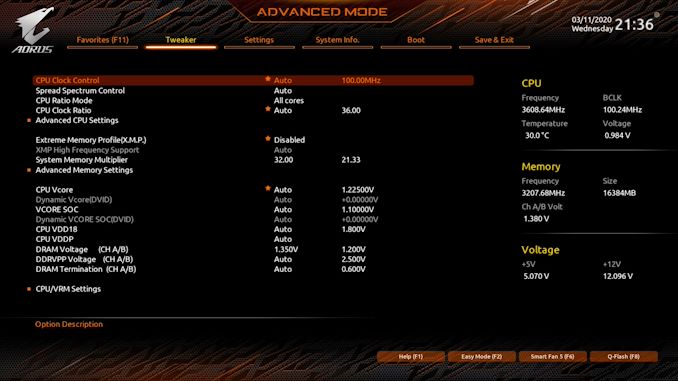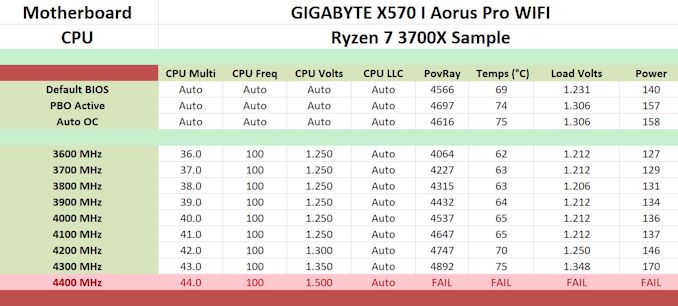On The Wings of an Eagle: GIGABYTE's X570 I Aorus Pro WIFI Motherboard Tested
by Gavin Bonshor on March 19, 2020 10:00 AM ESTOverclocking Ryzen 3000
Experience with the GIGABYTE X570 I Aorus Pro WIFI
It's no secret that Ryzen 3000 runs very warm when pushed beyond default settings and adequate cooling is a must. Our motherboard testing is focused on observing the behaviour and judging capability based on the hardware integrated onto the board including power delivery, circuitry, and other variables including the firmware which acts as the interface between the user and the hardware. One downside to mini ITX motherboards is that all the componentry is stacked tightly together and with this, it can produce more heat in comparison to other form factors with more sparse PCBs. This needs to be factored in when overclocking and it makes airflow even more important, especially in cramped spaces.
GIGABYTE's firmware is very easy to navigate around and all of the relevant overclocking settings can be found within the Tweaker section. Users doing basic overclocking can change key settings including CPU Ratio which will increase or decrease the CPU Core Frequency, and make CPU VCore adjustments for when the processor requires more juice to keep stable. Other important settings to consider include the CPU/VRM settings which allow users to select between different loadline calibrations, which can loosen or tighten the VDroop control for better stability in certain situations.
Memory overclocking can be achieved simply by enabling compatible memory with X.M.P 2.0 profiles or done manually by adjusting the memory frequency, the DRAM voltage, and adjusting latencies which can be found within the advanced memory settings menu. AMD recommends users keeping the FCLK (Infinity Fabric Clock) to within 2:1 of the memory frequency, with DDR4-3600 being the reported sweet spot between performance and frequency. For DDR4-3600, the FCLK should be set to 1800 MHz for best performance.
Overclocking Methodology
Our standard overclocking methodology is as follows. We select the automatic overclock options and test for stability with POV-Ray and OCCT to simulate high-end workloads. These stability tests aim to catch any immediate causes for memory or CPU errors.
For manual overclocks, based on the information gathered from the previous testing, starts off at a nominal voltage and CPU multiplier, and the multiplier is increased until the stability tests are failed. The CPU voltage is increased gradually until the stability tests are passed, and the process repeated until the motherboard reduces the multiplier automatically (due to safety protocol) or the CPU temperature reaches a stupidly high level (105ºC+). Our testbed is not in a case, which should push overclocks higher with fresher (cooler) air.
Overclocking Results
Our experience overclocking the GIGABYTE was a pleasant one and this board exceeded our expectations. For general users, GIGABYTE has gone with a very basic firmware with all the relevant settings in one easy to navigate place. As with all other X570 models tested, we managed to achieve 4.3 GHz on our Ryzen 7 3700X testbed processor with a CPU VCore of 1.350 V. All throughout our overclock testing, VDroop was tight with the LLC settings set to default, and we didn't experience any abnormalities in our testing.
Although GIGABYTE doesn't include any overclocking presets, the EasyTune software comes with a setting called Auto OC which labels itself as an automatic overclocking setting which we assumed is based on a basic lookup table. We didn't achieve any extra performance over enabling PBO, which proved slightly better than default settings at the cost of extra heat and power consumption. In our POV-Ray testing and testing from 3.6 to 4.3 GHz, performance increased gradually as expected.












63 Comments
View All Comments
InTheMidstOfTheInBeforeCrowd - Friday, March 20, 2020 - link
Oh, i don't doubt that. Even el cheapo fans can stay silent. For the first dozen months or so....ijozic - Friday, March 20, 2020 - link
IIRC, Asus X570-E doesn't have a chipset heatsink fan. I'd presume there are others, but that's one I've noticed.InTheMidstOfTheInBeforeCrowd - Friday, March 20, 2020 - link
Now, unfortunately that is neither mATX nor mITX. Also -- and this is obviously totally subjective -- does it feel normal to pay more for a motherboard than, say, for example a Ryzen 7 3700X?evernessince - Saturday, March 21, 2020 - link
Sure, assuming the fan isn't turned off completely. Passive mode exists and what many boards use when you aren't utilizing PCIe 4.0 bandwidth. I also have an old Z78 Sabertooth with an even smaller fan that's still perfectly functioning. Now that is a board built to last. In the end the quality of the fan really matters.InTheMidstOfTheInBeforeCrowd - Friday, March 20, 2020 - link
Yeah, this can work for people that build an entirely new system, thus being able to select components such CPU cooler and or GPU and a mobo with an acceptable layout (with regard to the placement of the chipset hub) so that they don't spatially interfere with each other.Unfortunately, i am intending to do an upgrade of an existing system instead of building a completely new one from scratch, and i intend to keep my GPU and CPU cooler. Both are too fat (wide/long) and are not leaving enough room for any passive chipset heatsink of any meaningful size :( (Form factor in my case is mATX or smaller. ATX and E(-peen)-ATX are not under consideration.)
PeachNCream - Friday, March 20, 2020 - link
I have to agree with you, moreso on the chipset fan than anything else. It feels like a significant step backwards to see them on motherboards and speaks of immature technology behind PCIe 4.0 to be in a state that the higher bandwidth bus requires active cooling.evernessince - Saturday, March 21, 2020 - link
It's in all the next gen consoles. I wouldn't call that immature.PeachNCream - Sunday, March 22, 2020 - link
And what sort of cooling do they have inside of them?Cashmoney995 - Thursday, March 19, 2020 - link
I currently cannot find an x570 Micro board with SP/DIF...still rocking my Z5500's from over a decade ago...Plenty of B450 board with this port, so wonder if this is a concious decision to segment the purchasers.supdawgwtfd - Thursday, March 19, 2020 - link
That interface is basically dead.Anything better than DVD provides better sound than it is capable of.